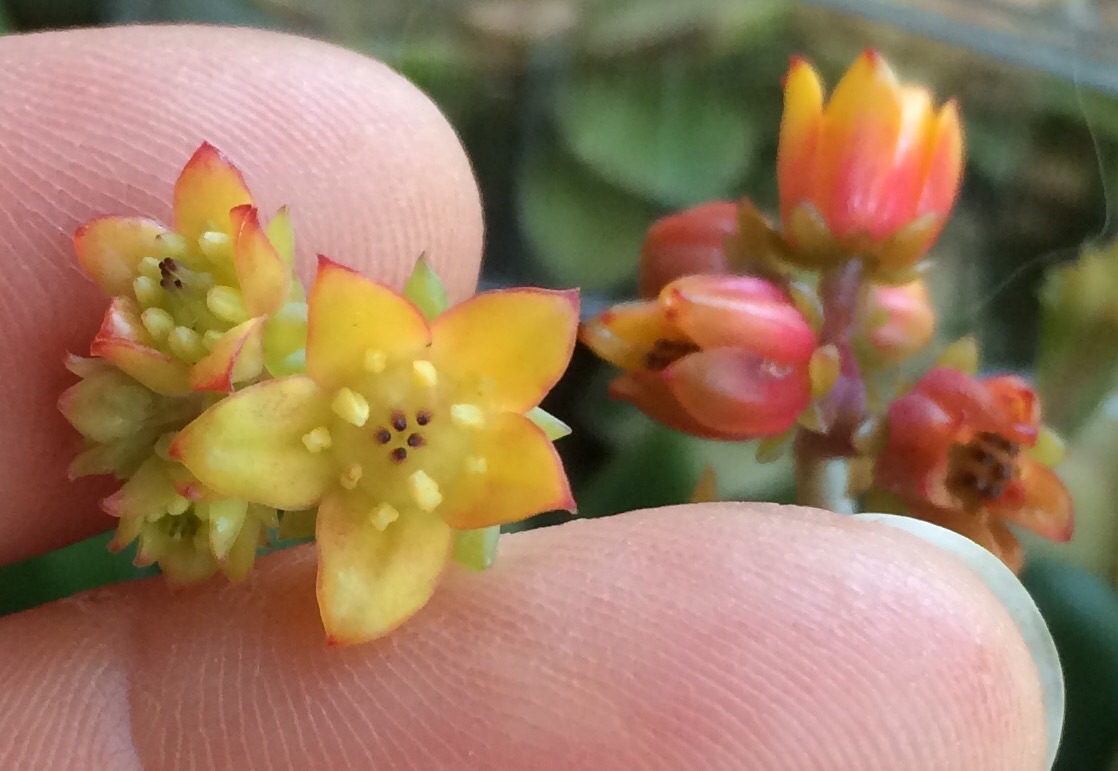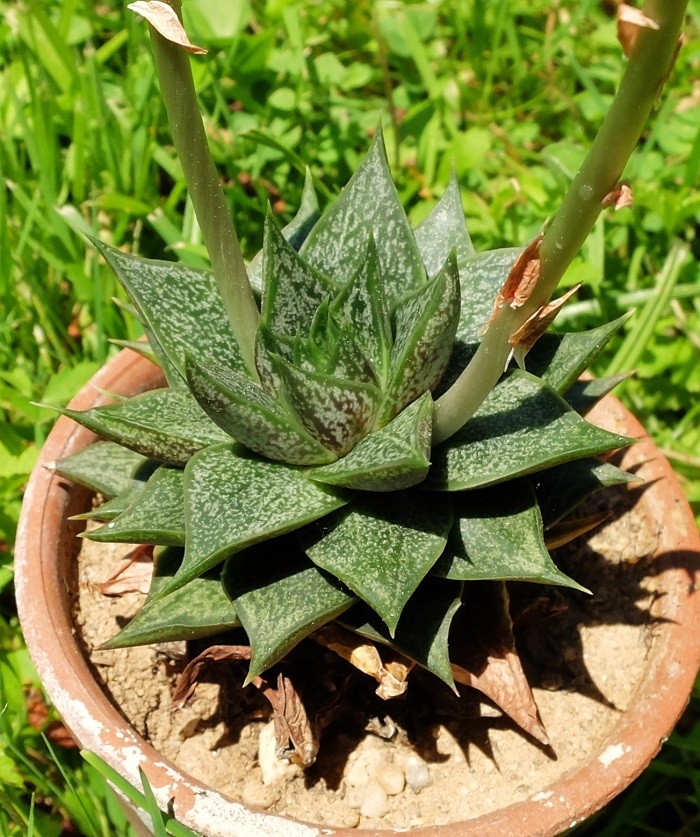You are not logged in.
- Topics: Active | Unanswered
Pages: 1
#1 2015-06-05 06:16:32
- Kwie2011
- Member
- Registered: 2015-05-27
- Posts: 15
Graptopetalum? Graptoveria?
I'd been told it was probably Echeveria purpusorum, but I'm learning a little more, and it isn't the flower of an Echeveria. Can anyone ID it?

Offline
#2 2015-06-05 16:13:22
- Tom
- Member

- Registered: 2011-09-08
- Posts: 1,722
Offline
#3 2015-06-05 20:47:29
- margrit
- Administrator
- Registered: 2007-09-03
- Posts: 5,388
Re: Graptopetalum? Graptoveria?
is it flowering for the first time ? this might explain that the flowers are somewhat misshaped.
Offline
#4 2015-06-09 19:55:16
- Kwie2011
- Member
- Registered: 2015-05-27
- Posts: 15
Re: Graptopetalum? Graptoveria?
They are flowering for the first time since I've had them, but it looked like one had a little bit of a spent inflorescence still stuck to it when I bought it last summer/fall. I have 2 full size rosettes on separate plants, and one small rosette growing from one of those. All three rosettes are flowering, and all three ha e these curiously fleshy flowers- the petals are succulent like leaves. They aren't like any petals I know.
Last edited by Kwie2011 (2015-06-09 19:56:52)
Offline
#5 2015-06-09 20:10:05
- margrit
- Administrator
- Registered: 2007-09-03
- Posts: 5,388
Re: Graptopetalum? Graptoveria?
If the flowers of all three rosettes are the same = not normal Echeveria flowers, that means that this plant has a defect.
Offline
#6 2015-06-10 06:18:00
- Kwie2011
- Member
- Registered: 2015-05-27
- Posts: 15
Re: Graptopetalum? Graptoveria?
Can you clarify what you mean by a defect? Are you thinking its a spontaneous mutation, or something in the hybridization? Extra chromasome or something? Or do you mean it doesn't conform to some horticulture standard for the cultivar? I'm pretty new to this, so any help understanding would be appreciated.
Offline
#7 2015-06-10 16:16:11
- margrit
- Administrator
- Registered: 2007-09-03
- Posts: 5,388
Re: Graptopetalum? Graptoveria?
I think the plant is somehow diseased. And what would have caused this is impossible to know - as long as plants refuse to talk to us collectors ....
Offline
#8 2015-06-10 23:15:54
- pgpanayotov
- Member
- From: Bulgaria/Sofia
- Registered: 2015-06-04
- Posts: 7
Re: Graptopetalum? Graptoveria?
Hello,
For me it is a hybrid plant.
I vote for (Graptopetalum X Sedum) X Echeveria.
It is quite possible a mutation is encoutered.
Flower simetry looks incorrect probably result of mixing 2 times between simetry 5 and 7.
Sure I could be wrong and the plant is just graptosedum with defect.
Plese could you post measures of leaves, flowers, stems.
Also count of sepals, petals, stamens etc.
Are the flower formulas equvalent between all flowers?
Kind regards,
PETAR
Offline
#9 2015-06-11 06:17:59
- Tom
- Member

- Registered: 2011-09-08
- Posts: 1,722
Offline
#10 2015-06-11 08:03:57
- pgpanayotov
- Member
- From: Bulgaria/Sofia
- Registered: 2015-06-04
- Posts: 7
Re: Graptopetalum? Graptoveria?
Hello,
The overal form of the leaf and the inner part of the flower.
I could be wrong for sure ![]()
I plan to create a excel calculation table with information from different plant's parts in order to do quick identification and filtering. It will take time.
B.R.
Offline
#11 2015-06-11 11:01:52
- Tom
- Member

- Registered: 2011-09-08
- Posts: 1,722
Re: Graptopetalum? Graptoveria?
I see carpels, anthers, and more or less thick and shiny petals of E. purpusorum, without stamen filaments recurved like with Graptopetalum.
Look at this topic : one normal E. purpusorum and two others with misshaped flowers.
The second monster did it again this year, and I don't know why... ![]()
Offline
#12 2015-06-11 18:56:41
- margrit
- Administrator
- Registered: 2007-09-03
- Posts: 5,388
Re: Graptopetalum? Graptoveria?
There is no evidence at all that this is an intergeneric hybrid. It is a plant producing abnormal flowers which would best be discarded.
Offline
#13 2015-06-12 00:55:57
- Kwie2011
- Member
- Registered: 2015-05-27
- Posts: 15
Re: Graptopetalum? Graptoveria?
It is two separate plants. They might come from the same plant at some point, but I bought two separate adult plants.
I hadn't replied earlier because I didn't know how to respond to the suggestion that the plant is diseased. I realize you're the expert, Margrit's, but I can't wrap my head around the idea. What sort of disease would cause all flowers to change, but remain healthy and viable? Do you have any examples? Do you mean an infectious disease? Is that why you think I should discard it?
My best guesses, without a degree in botany or plant genetics, would be mutation, or an F2 or F3 hybrid. Hybrid with what, I don't have a clue. I've only recently developed an interest in succulents. Do any Crassulacea have such succulent petals?
I'm not going to discard them. They are beautiful, healthy plants, and I find the flowers interesting, if not exceptionally pretty. I will take those measurements for you, Petar, and I'll check that link, Tom. Those flowers are very, very close, aren't they? Your suggestions are so much closer to anything I've seen.
I like my little plants, and will be very disappointed if you're right, Margrit, so I hope you don't mind that I'm betting against you on this one.
Addendum:
I don't speak French, so I'm only able to understand a little of the thread you linked to, Tom (I can't translate it with only my mobile device), but I am intrigued by the comment about the effect of cold winter temperatures. I left all these plants out in the cold over the winter. I only brought them in when we expected a hard freeze. Do I understand that your plant produced normal flowers the next year? I will have to keep these warmer this winter and see what happens next season. Do you know the ideal winter temperatures for E. purpusorum or 'Glory'?
I'll try to translate the thread so I understand more later, but I'm intrigued.
Last edited by Kwie2011 (2015-06-12 01:26:56)
Offline
#14 2015-06-12 03:50:40
- Tom
- Member

- Registered: 2011-09-08
- Posts: 1,722
Re: Graptopetalum? Graptoveria?
I've got four E. purpusorum (one is maybe hybrid), two of them produce abnormal flowers and I don't know why. If they reoffend next year, I'll get rid of it, because the only thing I like about E. purpusorum is the globular flower. ![]()
But your plant is E. purpusorum hybrid, 'Glory' is just a suggestion, and if you like the rosette, why not cultivate it ?
Offline
#15 2015-06-12 16:15:38
- margrit
- Administrator
- Registered: 2007-09-03
- Posts: 5,388
Re: Graptopetalum? Graptoveria?
You are entirely free to keep or not keep your plant. And make an experiment next winter and do not let it outside in the cold. I would be very much surprised if the flowers would ever become normal. If the plant has a defect, then flowers will remain the same. If the abnormal flowers are the result of an attack of - for ex. - aphids, then there is a chance that next time they could be normal.
It is useless to speculate about the reasons for the abnormality. I understand you have bought it in a nursery. We do not know the soil the producer used, nor the fertilizer he used nor what other chemical means he might have used to quickly arrive at a saleable size. If you want to grow healthy plants I suggest you buy seeds and raise your own plants under controlled conditions.
Where do you live and how are your winters ?
Offline
#16 2015-06-16 19:55:45
- Kwie2011
- Member
- Registered: 2015-05-27
- Posts: 15
Re: Graptopetalum? Graptoveria?
I'm in the northwestern US. Winters here can be unpredictable. Last fall we only had a about 2 weeks when nights dropped below freezing and I brought them inside. Days in the 40s Farenheit, and nights right around freezing are typical.
Offline
#17 2015-06-16 20:24:03
- margrit
- Administrator
- Registered: 2007-09-03
- Posts: 5,388
Re: Graptopetalum? Graptoveria?
There may be plants which do not mind cold weather, but certainly there are also more delicate ones which would prefer some more warmth in winter. You will have to experiment.
Offline
#18 2015-06-16 20:44:56
- Kwie2011
- Member
- Registered: 2015-05-27
- Posts: 15
Re: Graptopetalum? Graptoveria?
I've only recently become interested in succulents, and I'm finding just that. Even within a genus, they vary a great deal. The dearth of sunshine here from fall through spring also presents a challenge. I keep mirrors behind my succulents until the sun comes out.
Offline
#19 2015-06-16 22:45:31
- pgpanayotov
- Member
- From: Bulgaria/Sofia
- Registered: 2015-06-04
- Posts: 7
Re: Graptopetalum? Graptoveria?
Kwie,
I also like your plant and I think it would be sad to discard it.
I love all my plants and it is very hard to me when I have to part with any of them.
I have done so only when I faced bug infestations that I cannot fix.
Even if your plant has mutation it is not for discarding since it is healthy looking and pretty.
B.R.
Petar
Offline
Pages: 1

